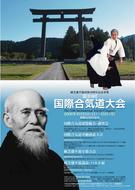Aikido 合気道
Ueshiba Morihei, Founder of Aikido
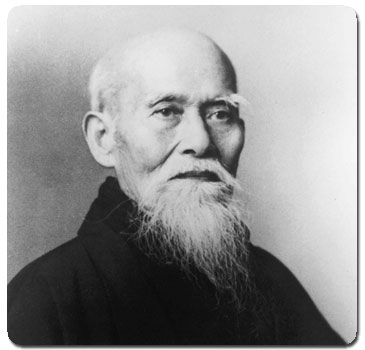
The founder of Aikido, Ueshiba Morihei, was born in Tanabe City, Japan. He started training for martial arts at an early age and started studying various martial arts when he turned 19. He then invented his own unique martial art based on his experiences. He named his new martial art “Aikido” in 1922, which gained popularity both domestically and internationally. Tanabe City thus awarded him the status of an honorary citizen in 1969 to celebrate his accomplishments.
“Aikido” is known for its technique to defeat one’s opponents at the instant of first contact. However, it is different from most other sports or martial arts, in that it is neither about defeating the opponent by force, nor about competition. Ueshiba always said, “Aikido is not about defeating one’s enemy. It is the way to unite human beings and guide the world toward harmony.” He also stated that Aikido is the martial art that focuses on developing ones’ inner self through training with and improving each other. In other words, Ueshiba believed that “Aikido is a guide for one to achieve one’s given fate. It is the path to reach harmony and love.”
His ideals have spread beyond Japan and developed into one of the most important schools of martial art throughout the world. In 1988, the 5th International Aikido Congress took place here in Tanabe and the 10th International Aikido Congress will be held here in October 2008. Ueshiba’s bronze statue was also built in Ogigahama Park as a monument to the 1988 event. The Ueshiba family’s grave, Ueshiba Morihei’s old resident, monument and other related sites were also preserved to celebrate his accomplishments.
Childhood
Ueshiba Morihei was born on December 14th, 1883, in Nisihitani Village, Nichimurou County, Wakayama Prefecture (currently known as Motomachi, Tanabe City). He was the eldest son between a farmer, Ueshiba Yoroku, and his wife, Yuki. After finishing elementary school, he went to Wakayama Daini Junjo middle school. However, he dropped out of middle school after finishing his freshman year. Instead, he entered Yoshida Abacus Academy to study the abacus, and became a tax official using the skill sets he obtained there.
However, in 1901, new fishery acts were established and led to heavy taxation on the local fishermen. Ueshiba set aside his duty and sympathized with the fishermen and participated in strikes with them, which eventually led to his resignation. As a result, he decided to work in Tokyo and moved when he turned eighteen.
The Road Toward Martial Arts
Despite experiencing hardship while living in Tokyo, Ueshiba studied Kitou School of Judo and started training for Shinkage School of Kendo. However, he had to return home due to his health conditions. After recovering at home, he married his childhood friend Hatsu Itogawa (born in 1881). Then he joined the military under the fourth division of Osaka, 37th regiment.
Ueshiba participated in the Russo-Japanese War in 1905. He was then recommended to go to military academy due to his outstanding performance. However, Ueshiba left the army and returned home to succeed his family business. While farming and training at home, he met Kodokan Judo Master Takagi Kiyoshi who visited Tanabe at that time. Ueshiba then reformed part of his house into a dojo for Takagi to train him with the local youths. Meanwhile, the Meiji government declared the policy to merge local shrines. With help from naturalist Minagata Kumagusu, Ueshiba and the local youth campaigned against the policy, which helped contain the damage of many historical shrines to a minimum.
Settlement in Hokkaido
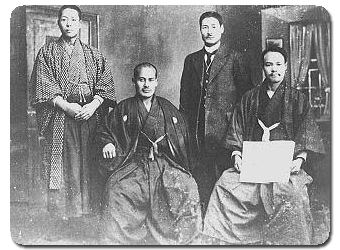
In spring 1910, Ueshiba Morihei found out about the recruit for new settlements in Hokkaido. He gathered volunteers from 54 local families, which add up to about 80 people. Ueshiba organized the volunteers to form “Kishu Group”, and led them to settle in Kamiyuubetsu Village (currently Shirataki Village, Monbetsu County). The settlement took 2 years due to the harsh conditions, but eventually succeeded. Ueshiba Morihei was thus called “King of Shirataki” by the villagers. Even in such a harsh situation, Ueshiba Morihei’s devotion to martial arts did not wither. While in Hokkaido, he met Takeda Sokaku, master of Daito-ryu Jujutsu at a hotel in Engaru County and invited him to the village for training. On May 23rd, 1917, a huge fire struck Kamiyuubetsu Village and destroyed nearly all the settled area. Ueshiba Morihei and the villagers cooperated on rebuilding the village. In 1918, Ueshiba Morihei became a representative of the village. However, he received a telegraph about his father’s critical illness and returned home leaving his position and property behind.
The Ueshiba Training School in Ayabe, Kyoto
On the return trip home, Ueshiba Morihei heard that there is a place in Ayabe to pray for one’s recovery. He stopped by and met the spiritual leader of Omoto-kyo, Deguchi Onisaburo, who lectured him on ways of living. Sadly, when Ueshiba arrived in Tanabe, his father has already passed away.
In 1920, Ueshiba moved his family to Ayabe, Kyoto. He continued training both his body and mind and founded “Ueshiba School”. He trained with his followers under the fundamental idea of the Ueshiba School, which combines martial art and agriculture. This is also when Aiki-bujutsu, the martial art that unites one’s heart, body and spiritual energy, slowly takes on its current form.
The Rising of Aikido
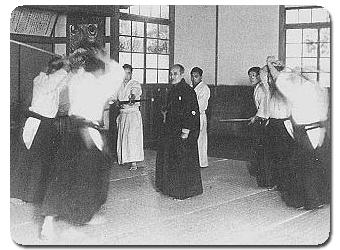
As Aikido gained reputation, Admiral Takeshita Isamu invited Ueshiba and his pupils to demonstrate Aiki Bujutsu in Tokyo. Their performance affected even the members of the Imperial Household Agency, which led to a special lecture that lasted 21 days. After the great success of the demonstration, Ueshiba Morihei received many invitations from celebrities and marine officers for more demonstrations. As a result, Ueshiba Morihei decided to move his family to Tokyo in 1927 and set up a temporary Dojo in his new resident. While teaching Aikido, he also worked as an instructor of martial arts in Marine College, spreading the ideal of Aiki bujutsu. Due to the growing popularity, Ueshiba Morihei started to build his own dojo. At the same time, he opened another temporary dojo in Shimo Ochiai, Mejiro. When Kano Jigoro, the founder of Koudoukan Judo, visited this dojo, Aikido’s balanced training of the mind, the body and spiritual energy really impressed him. He thus sent his own pupils to Ueshiba Morihei’s dojo for training in Aikido as well.
In April 1931, the first official Dojo, located in Ushigome Wakamatsu Town (currently known as Wakamatsu town, Shinjuku Ward), Kobukan (currently known as Aikikai Hombu Dojo), finally opened. It was called the “Hellish Dojo” of Ushigome, which housed many of Ueshiba’s top private pupils. Following Kobukan, he built many other dojos in Tokyo and Osaka, and changed the name “Aiki bujutsu” to “Aiki Budo”. On April 30th, 1940, the Ministry of Health and Welfare licensed Aikido under the name “Kobukai Foundation”. In 1942, “Aiki Budo” had its final name-change, and finally became “Aikido” as known today.
Agriculture and Martial Arts as One
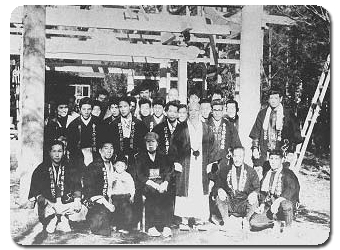
In order to reach the ideal that martial art and agriculture share the same roots, Ueshiba moved to Iwama town, Ibaraki prefecture. While reclaiming the forest into farmland, he spent two years from 1943 to build the Aiki Shrine and the Aiki training ground. This became the new stronghold of Aikido after WWII. In 1948, the Ministry of Education certified the “Aikikai Foundation”.
The Essence of the Martial Art of Harmony
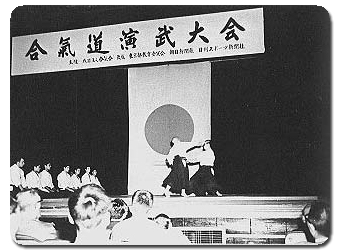
After mastering the way of Aikido in Iwama town, Ueshiba Morihei once again started promoting martial arts in 1950. In his 70s, his techniques were so mature and well-rounded that it perfectly demonstrated the ideal of harmony.
In 1956, Ueshiba invited ambassadors and ministers from all over the world for his demonstration, which was also the first one after WWII. The Nippon Television Network Corporation produced the show “The Throne of Aikido” in 1960. Ueshiba received the Shiju Medal for his achievements. In addition, he also received in 1964 a Kyokujitsu small medal.
Ueshiba Morihei’s final days
In 1969, he was awarded honorary citizen of Tanabe City, Wakayama and honorary citizen of Iwama town. He passed away on April 26th of the same year at age 86. He then received Seigoi Gunsantou Zuiho medal (Orders of the Sacred Treasure) as his final award. On May 2nd, Tokyo, Iwama Town and Tanabe City all held memorial service for him. His remains were buried in Kozan-ji Temple, Tanabe City, which Aikido followers from all over the world come to visit even today.
Aikido Sites
Ueshiba Morihei Gravesite
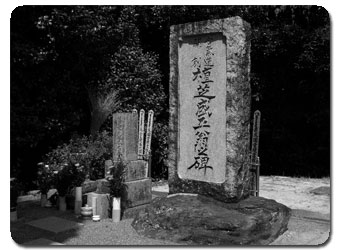
Ueshiba Morihei, the founder of Aikido was born in the city of Tanabe. His resting place is located on the Kozanji Temple grounds close to the station.
This grave site is a mecca for passionate Aikido practitioners who visit to pay their respects to their founder.
Ueshiba Morihei Memorial Museum
The Ueshiba Morihei Memorial Museum is housed in the state-of-the-art Tanabe Municipal Budokan near Ogigahama beach about 10-minute walk from the Kii-Tanabe train station.
The intimate space invites visitors to immerse themselves in the world of Japanese martial arts. After slipping into indoor shoes and passing through the futuristic sliding doors you are immediately faced with Morihei’s beautiful calligraphy and samples of his famous “doka” poetry.
The installations which follow, provide information that is accessible even to those with no prior knowledge of martial arts.
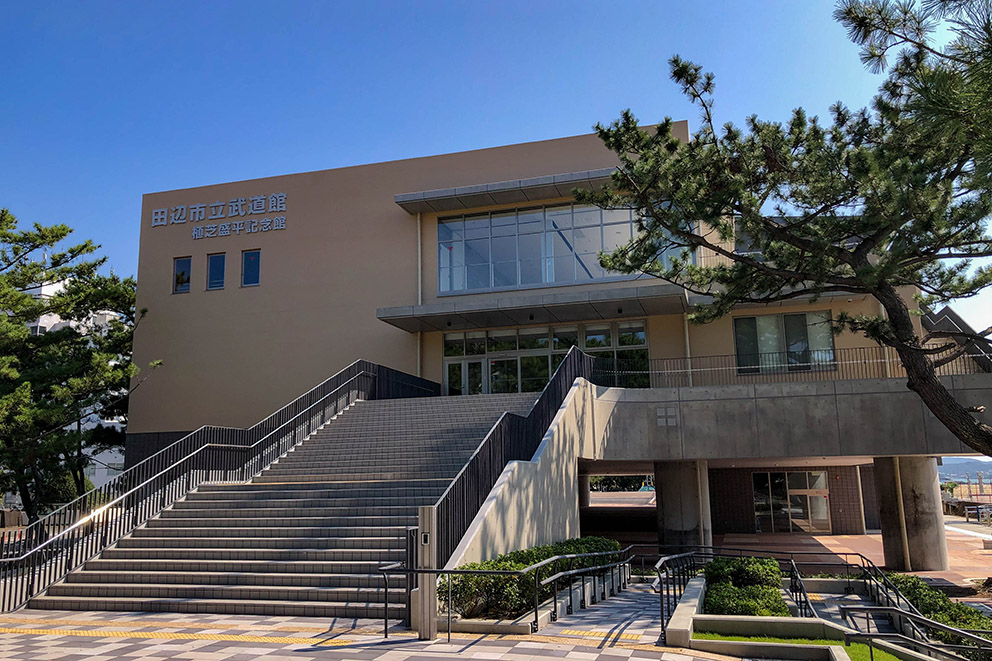
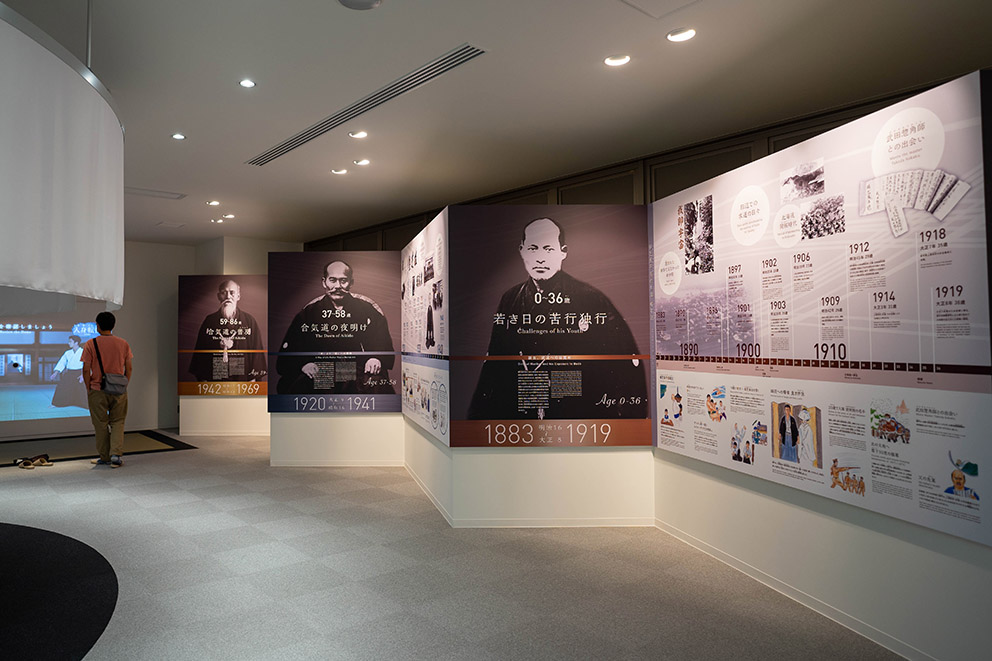
Hours: 10:00 to 17:00
Closed: Mondays (if Monday is a national holiday then closed next business day), and New Years Holiday.
Price: Free
Ueshiba Morihei Bronze Statue
The Bronze Statue of Ueshiba Morihei is located in front of the Tanabe Municipal Budokan near the Ogigahama Beach in Tanabe City.
It was erected in 1988 during the first International Aikido Congress that was held in the city.
This statue is visited by Aikido practitioners around the world.
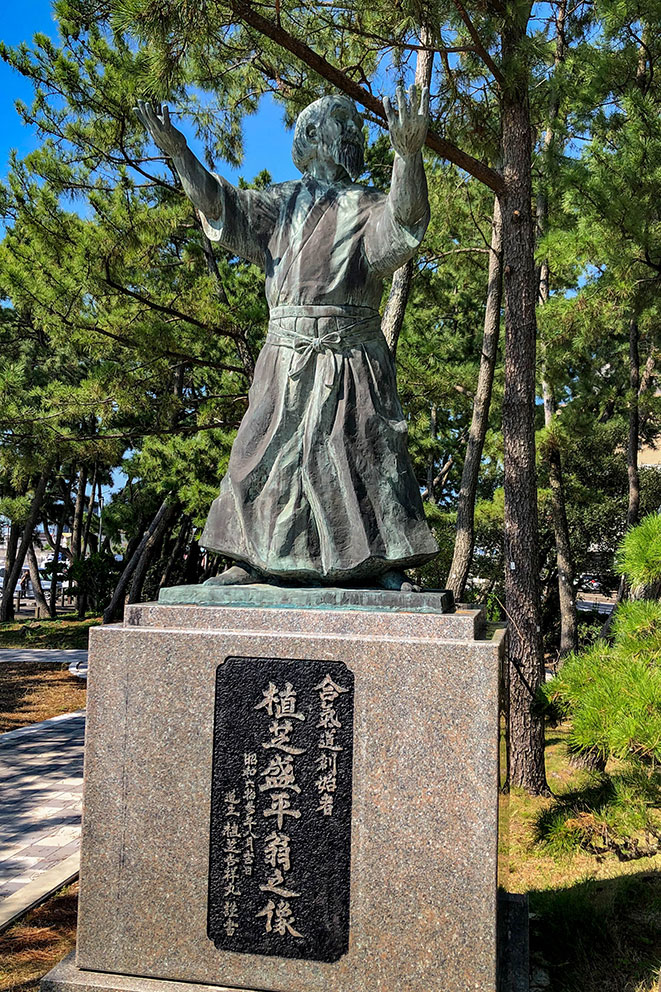
IAF International Aikido Congress 2008 in Tanabe
The International Aikido Federation (IAF) held the 2008 International Aikido Congress from October 5th to 13th, 2008 in the city of Tanabe. During the Congress, there were seminars and the IAF General Assembly. Tanabe is the birthplace of Ueshiba Morihei, the founder of the martial art Aikido.
Thank you very much to all those who participated from around the world. It was an incredible turnout and we were very thrilled to have hosted this event and to have had the opportunity to share the spirit of Aikido and Kumano with the rest of the world.
Also, a very special thank you goes out to the organizing staff and dozens of volunteers, without who we would have not been able to successfully complete this World-class event.
For Aikidoists who have not yet had a chance to pilgrimage to Kumano, Aikido’s roots, please come and visit soon.
Gravesite ceremony, October 6th
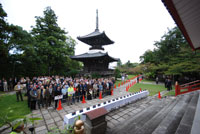
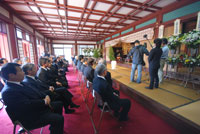
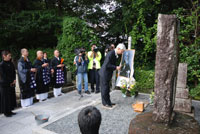
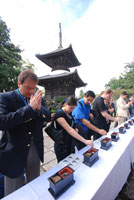
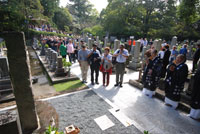
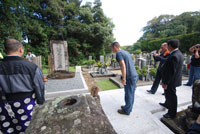
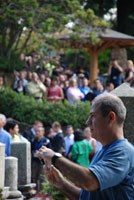
Seminars

Over 600 Aikidoists from 49 countries are attending the Aikido congress in Tanabe.
Demonstrations

Like ghosts flying gracefully through the sacred air, aikidoist make their offerings of form to the Kumano Deity at one of the most sacred sites in Japan; Oyunohara, the former shrine ground of Kumano Hongu Taisha.
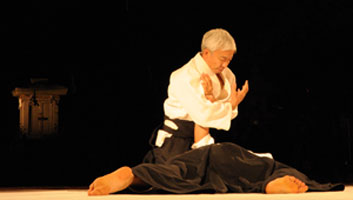
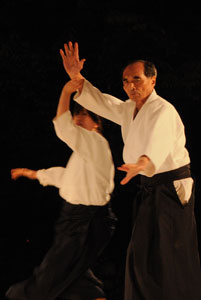
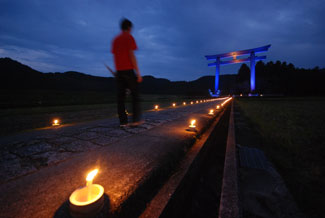
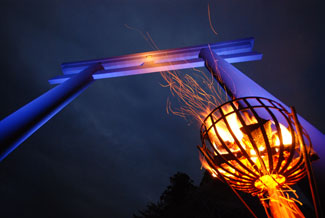
Ueshiba Morihei & Kumano
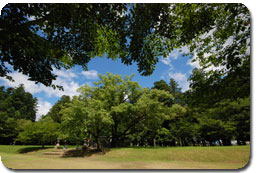
Ueshiba Morihei was born in the City of Tanabe, the entrance to the sacred Kumano region of Japan. Kumano is a prehistoric sacred site based on nature worship. With the introduction of Buddhism to Japan a unique form of Buddhist-Shinto syncretism took place. It was Kumano’s rich spiritual context that deeply influenced Ueshiba and he often returned to his roots to train. It is said that Ueshiba mastered the way of Aikido in Kumano. The demonstration will be taking place at Oyunohara (pictured left), the original site of the Kumano Hongu Taisha.
Aikido Congress Leaflet
Aikido Experience
Experience the energy of Aikido firsthand in Tanabe! Touch the spirit of Japanese martial arts by being a part of an authentic Aikido training session in the birthplace of its founder. Book unique, local Aikido tours online!

